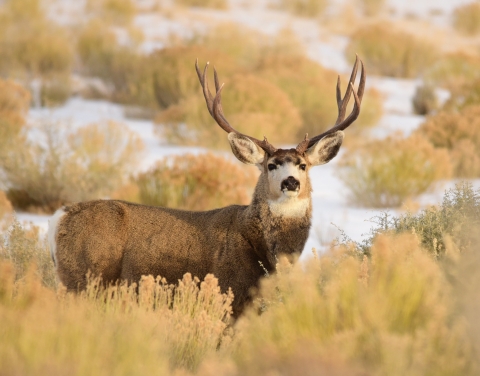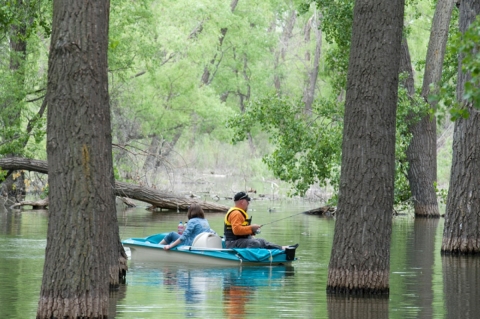About Us
North Platte National Wildlife Refuge lies in the Panhandle of Western Nebraska. Established in 1916, the Refuge is superimposed over four Bureau of Reclamation irrigation projects: Lake Minatare, Winters Creek Lake, Lake Alice, and Stateline Island.
Boasting abundant wildlife, the North Platte NWR units contain a mixture of native prairie and woodland habitat. Whether the Refuge unit is surrounded by water (Stateline Island) or bordering a reservoir (Lake Alice, Lake Minatare, and Winters Creek), riparian riparian
Definition of riparian habitat or riparian areas.
Learn more about riparian habitat is a key feature of this Refuge.
The water bodies attract an abundance of waterfowl and shorebirds, and the riparian edges support songbirds, raptors, and a variety of other birds. Additionally, 21 mammals including both mule and white-tailed deer, may be seen throughout the year. During the warmer months, 17 species of reptiles and amphibians may also be observed.
Our Mission
Each unit of the National Wildlife Refuge System is established to conserve native species and the lands and waters on which they depend. All activities on those acres are reviewed to ensure they are compatible with the refuge purpose.
North Platte National Wildlife Refuge was established in 1916 by Executive Order No. 2446 as a “preserve and breeding ground for native birds.” It is located in the Nebraska Panhandle, near Scottsbluff, Nebraska. It was declared a National Wildlife Refuge primarily because of large fall concentrations of up to 250,000 mallards, 11,000 Canada geese and bald eagles.
Our History
The North Platte National Wildlife Refuge is made up of Lake Minatare, Winter's Creek Lake, Lake Alice and Stateline Island in the North Platte River. While portions of Winters Creek Lake and Lake Alice are closed to all public entry, the remainder is open to a variety of public uses most of the year.
Originally, the Refuge included four irrigation reservoirs which were constructed between 1910 and 1917. Three of these are still part of the Refuge: Lake Minatare - 737 acres; Winters Creek - 536 acres; and Lake Alice - 1,500 acres. The Little Lake Alice reservoir was removed from the Refuge System in 1961. In 1990, the Fish and Wildlife Service assumed management of Stateline Island, a 136-acre diversion project on the North Platte River.
Recreation at Lake Minatare has an established importance to the community, so a portion of the lake (2,470 acres) was removed from the Refuge System by Congress in 1996, with provision that the site would be closed during fall and winter months to provide a safe resting place for migratory birds.
Other Facilities in this Complex
North Platte National Wildlife Refuge is administered as part of the Sandhills National Wildlife Refuge Complex which includes Fort Niobrara NWR, Valentine NWR, Crescent Lake NWR, Lacreek NWR and John W. and Louise Seier NWR.
Lacreek National Wildlife Refuge lies in the shallow Lake Creek valley on the northern edge of the Nebraska Sandhills and includes 16,410 acres of native sandhills, sub-irrigated meadows, impounded fresh water marshes, and tall and mixed grass prairie uplands. The Refuge serves as an important staging area for migrating waterfowl, sandhill cranes, shorebirds, and neotropical migrants. Providing critical wintering habitat for the high plains trumpeter swan population is a primary goal.
Fort Niobrara National Wildlife Refuge was once a frontier military fort, supports an exceptional diversity of plants and wildlife representative of the northern Great Plains and geographic regions east, west, north, and south of here. In the early 1900s, President Theodore Roosevelt and private conservation organizations, such as the National Audubon Society and American Bison Society, were becoming increasingly concerned with the exploitation of wildlife and their habitats on the Great Plains and elsewhere. As a result, an Executive Order was signed on January 11, 1912, establishing Fort Niobrara as a "preserve and breeding ground for native birds." Later that year, the Refuge's purpose was expanded to include the conservation of bison and elk herds representative of those that once roamed the Great Plains.
Valentine National Wildlife Refuge is 71,516 acres and is located in the Sandhills of north-central Nebraska. The Refuge is a unique and ecologically important component of the National Wildlife Refuge System (System) which includes more than 566 National Wildlife Refuges spanning approximately 100 million acres of lands and 750 million acres of oceans in the United States. The native grass prairie and wetlands found here support a diversity of wildlife. Little has changed from historic times. The Refuge was established by Congress in 1935 “as a breeding ground for migratory birds and other wildlife.” The Refuge is home to 270 species of birds, 59 species of mammals, and 22 species of reptiles and amphibians.
Crescent Lake National Wildlife Refuge lies on the southwestern edge of the Nebraska Sandhills, the largest sand dune in the Western Hemisphere. The Sandhills are characterized by rolling, vegetated hills and interdunal valleys. These habitats on the Refuge are interspersed with 21 wetland complexes—shallow lakes, marshes, seasonal wetlands, wet meadows, and a small stream. Wildlife diversity, except large ungulates and their predators, is relatively unchanged since early settlement.
John W. and Louise Seier National Wildlife Refuge is found in north-central Nebraska, as a sanctuary among the Sandhills. The Sandhills region is the largest remaining tract of mid and tall grass prairie in North America. The Seier Ranch was originally homesteaded by John and Louise Seier’s grandparents in the mid-1800's. John and Louise Seier donated, their 2,400 acre working cattle ranch to U.S. Fish and Wildlife Service in October of 1999. Because the Refuge is so new to the System, it remains closed to the public at this time. There is no projected date for the opening of the Refuge, however, a date will be established upon the completion of a management plan.








